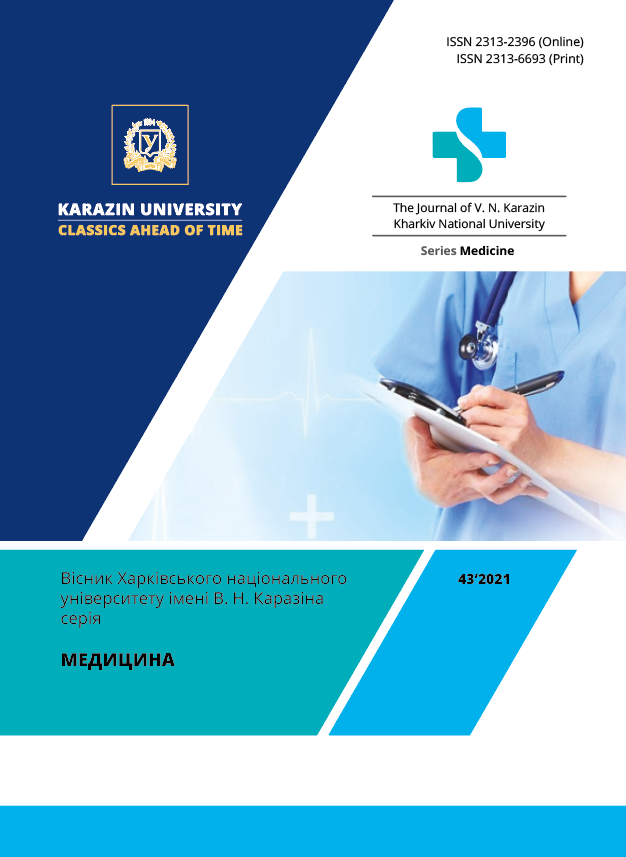Clinical and immunological efficiency of different therapy schemes in patients with infectious mononucleosis caused by Epstein-Barr virus
Abstract
Abstract. The study of the role of Epstein-Barr virus infection in the development of various human pathological conditions is of great importance. This is due to the significant epidemiological role and social significance, because according to epidemiological data, more than 90 % of people are infected with VEB when they reach adulthood. The steady increase in the number of diseases caused by VEB in both adults and children is associated with its specific susceptibility to immunocompetent cells, lifelong persistence and latent course, which necessitates a comprehensive study and development of effective treatments. The aim of this study was to evaluate the effectiveness of ribonucleic acid in the correction of immune disorders in patients with infectious mononucleosis caused by Epstein-Barr virus. Materials and methods: To achieve this goal, 110 patients with IM were examined, including 58 women (52.7 %), men – 52 (47.3 %). The mean age of patients was 23.3 ± 4.2 years. The material for the study was the serum of patients obtained in the dynamics of the disease. The complex of examination of patients with IM included clinical and biochemical methods, enzyme-linked immunosorbent assay, polymerase chain reaction method, immunogram. The results of the research were processed by the method of variation and correlation statistics using the program «Statistica 10.0 for Windows». The analysis of the obtained results allowed to establish that in patients with IM changes in the system of cellular and humoral parts of the immune system and the diversity of the immune response were detected. The progressive nature of changes in immune parameters indicates the formation of secondary cellular immune imbalance, activation of the humoral link, a change in the balance of immunoregulatory mediators towards Th2 cells. In the acute period, probable disorders of the cellular immune system, characterized by an increase in the number of cells with killer activity: mature T-lymphocytes (CD3+), cytotoxic T-suppressor cells (CD8+), cells expressing the activation marker CD25+ (receptor IL2) and increase Th1/Th2. Under the influence of complex immunomodulatory and antiviral action with the appointment of ribonucleic acid, there is a more positive dynamics of immunological parameters compared with patients who received only basic therapy, which is manifested by an increase in the proliferative response. Conclusions. For the correction of immune disorders in patients with IM, associated with VEB the use of complex therapy with the drug nuclex (ribonucleic acid) (250 mg) 2 capsules 3 times a day for 14 days and valaciclovir (500 mg) at a dose of 1000 mg (2 table) 3 times a day for 14 days.
Downloads
References
Luzuriaga К, Sullivan JL. Infectious mononucleosis. NEJM. 2010;362(21):1993– 2000. DOI: https://doi.org/10.1056/NEJMcp1001116
Odumade OA, Hogquist KA, Balfour HH. Progress and problems in understanding and managing primary Epstein – Barr virus infections. Clin. Microbiol Rev. 2011; 24 (1): 193–209. DOI: https://doi.org/10.1128/CMR.00044-10
Drozdova NF, Fazylov VH. Infectious mononucleosis caused by Epstein-Barr virus: clinicopathogenetic aspects (literature review). Bulletin of modern clinical medicine. 2018; 11 (3): 59–61. Available from: https://cyberleninka.ru/article/n/infektsionnyy-mononukleoz-obuslovlennyy-virusom-epshteyna-barr-kliniko-patogeneticheskie-aspekty-obzor-literatury (access date: 08.07.2021). [in Russian]
Balfour HHJr, Dunmire SK, Hogquist KA. Infectious mononucleosis. Clin Transl Immunol. 2015; 4 (2): e33. DOI: https://doi.org/10.1038/cti.2015.1
Demina OI, Chebotareva TA, Mazankova LN, Tetova VB, Uchaeva ON. Clinical manifestations of infectious mononucleosis in primary or reactivated herpes virus infection. Rossiyskiy Vestnik Perinatologii i Pediatrii (Russian Bulletin of Perinatology and Pediatrics). 2020; 65 (1): 37–44. (In Russ.) DOI: https://doi.org/10.21508/1027-4065-2020-65-1-37-44
Solomay TV, Semenenko TA, Filatov NN, Kolbutova KB, Oleinikova DYu, Karazhas NV. The role of children and adults as a reservoir of pathogens during the seasonal rise in the incidence of upper respiratory tract infections. Children infections. 2020; 19 (3): 5–11. (In Russ.), DOI: https://doi.org/10.22627/2072-8107-2020-19-3-5-11
Isakov VA, Arhipova EI, Isakov DV. Herpesviral infections in human (2nd edition, revised and enlarged): Guidelines for physicians. Saint Petersburg : SpecLit. 2013. 13 p. [in Russian]
Balfour HH, Odumade OA, Schmeling DO, et al. Behavioral, virologic, and immunologic factors associated with acquisition and severity of primary Epstein-Barr virus infection in university students. J. Infect. Dis. 2013; 207: 80–88. DOI: https://doi.org/10.1093/infdis/jis646
Vozianova ZH, Hley AI. I. Infektsiyniy mononukleoz yak polietiolohichne zakhvoryuvannya. Suchasni infektsiyi. 2004; 2: 37–41. [In Ukrainian].
Thorley-Lawson DA, Hawkins JB, Tracy SI, Shapiro M. The pathogenesis of Epstein-Barr virus persistent infection. Current opinion in virology. 2013; Jun; 3 (3): 227–32. DOI: https://doi.org/10.1016/j.coviro.2013.04.005
Helsinki Declaration of the World Medical Association «Ethical principles of medical research with human participation as an object of study» [Electronic resource]. 2008. Available from: http://zakon2.rada.gov.ua/laws/show/990_005 (access date: 16.05.2017). [in Ukraine]
The Journal of V. N. Karazin Kharkiv National University, series Medicine has following copyright terms:
- Authors retain copyright and grant the journal right of first publication with the work simultaneously licensed under a Creative Commons Attribution License that allows others to share the work with an acknowledgement of the work’s authorship and initial publication in this journal.
- Authors are able to enter into separate, additional contractual arrangements for the non-exclusive distribution of the journal’s published version of the work, with an acknowledgement of its initial publication in this journal.
- Authors are permitted and encouraged to post their work online prior to and during the submission process, as it can lead to productive exchanges, as well as earlier and greater citation of published work.




